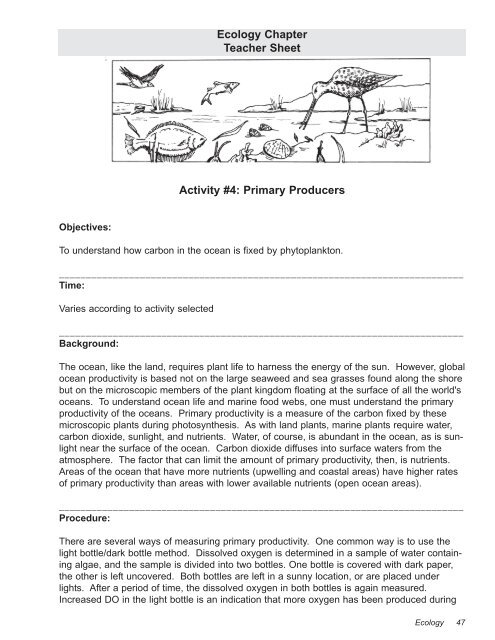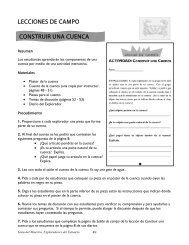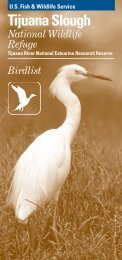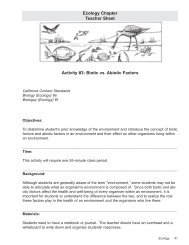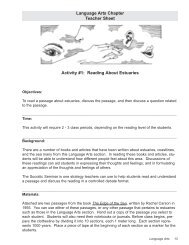Primary Producers - Tijuana Estuary : TRNERR
Primary Producers - Tijuana Estuary : TRNERR
Primary Producers - Tijuana Estuary : TRNERR
You also want an ePaper? Increase the reach of your titles
YUMPU automatically turns print PDFs into web optimized ePapers that Google loves.
Ecology Chapter<br />
Teacher Sheet<br />
Activity #4: <strong>Primary</strong> <strong>Producers</strong><br />
Objectives:<br />
To understand how carbon in the ocean is fixed by phytoplankton.<br />
___________________________________________________________________________<br />
Time:<br />
Varies according to activity selected<br />
___________________________________________________________________________<br />
Background:<br />
The ocean, like the land, requires plant life to harness the energy of the sun. However, global<br />
ocean productivity is based not on the large seaweed and sea grasses found along the shore<br />
but on the microscopic members of the plant kingdom floating at the surface of all the world's<br />
oceans. To understand ocean life and marine food webs, one must understand the primary<br />
productivity of the oceans. <strong>Primary</strong> productivity is a measure of the carbon fixed by these<br />
microscopic plants during photosynthesis. As with land plants, marine plants require water,<br />
carbon dioxide, sunlight, and nutrients. Water, of course, is abundant in the ocean, as is sunlight<br />
near the surface of the ocean. Carbon dioxide diffuses into surface waters from the<br />
atmosphere. The factor that can limit the amount of primary productivity, then, is nutrients.<br />
Areas of the ocean that have more nutrients (upwelling and coastal areas) have higher rates<br />
of primary productivity than areas with lower available nutrients (open ocean areas).<br />
___________________________________________________________________________<br />
Procedure:<br />
There are several ways of measuring primary productivity. One common way is to use the<br />
light bottle/dark bottle method. Dissolved oxygen is determined in a sample of water containing<br />
algae, and the sample is divided into two bottles. One bottle is covered with dark paper,<br />
the other is left uncovered. Both bottles are left in a sunny location, or are placed under<br />
lights. After a period of time, the dissolved oxygen in both bottles is again measured.<br />
Increased DO in the light bottle is an indication that more oxygen has been produced during<br />
Ecology 47
photosynthesis than has been used during respiration, since oxygen is a waste product of<br />
photosynthesis. Stable or decreased DO indicates no photosynthesis has occurred, or it indicates<br />
that more oxygen has been used during respiration than has been produced during<br />
photosynthesis. The dark bottle is a measure of respiration only, and can therefore be used to<br />
assess exactly how much O2 was used up.<br />
Another method commonly used by scientists is satellite imagery. Since marine algae contain<br />
chlorophyll and other photosynthetic pigments, the color of a body of water from a satellite<br />
image can be used to determine productivity.<br />
Listed below are several websites that contain productivity lessons for students. The first<br />
one, Message in the Bottles, estimates primary productivity using the light/dark bottle method.<br />
It is a pdf file that contains a teacher guide and can be printed and used in the classroom.<br />
The next two are SeaWiFS projects from NASA that students complete online using satellite<br />
imagery. The last two are instructional modules using real-time data from the Atlantic - one off<br />
the coast of New Jersey and the other from the Gulf Stream.<br />
Based on time constraints, available technology, and class size, select one or more of these<br />
lessons for your students.<br />
1.http://oceanexplorer.noaa.gov/explorations/02arctic/background/education/media/arctic_mes<br />
sage.pdf<br />
Estimating primary productivity. Identify the three realms of the Arctic Ocean, and<br />
describe the relationships between these realms, explain the relationships between<br />
gross primary productivity, net primary productivity, and respiration and understand<br />
how oxygen production and consumption can be measured and used to estimate primary<br />
productivity in water bodies.<br />
2. http://seawifs.gsfc.nasa.gov/SEAWIFS/LIVING_OCEAN/<br />
SeaWiFS Project - Studying Ocean Color From Space - Teacher's Guide with Activities<br />
3. http://seawifs.gsfc.nasa.gov/SEAWIFS/sanctuary_1.html<br />
Monitoring the Earth from Space with SeaWiFS<br />
4. http://www.coolclassroom.org/home.html<br />
The COOL Classroom is a series of Internet-based instructional modules that link<br />
middle and high school classrooms with active research investigations at the Rutgers<br />
Marine & Coastal Sciences (RMCS) COOLroom, a collaboration of oceanographers<br />
studying the coastal ocean off the coast of New Jersey. Here you will find information<br />
about how to use the COOL projects and printable teachers guides.<br />
Ecology 48
5. http://k12science.ati.stevens tech.edu/curriculum/gulfstream2/teacherguide.shtml<br />
The Gulf Stream Voyage is an online multidisciplinary project which utilizes both real<br />
time data and primary source materials to help guide students to discover the science<br />
and history of the Gulf Stream. Students will investigate the driving forces behind this<br />
great ocean current, how it affects the Atlantic Ocean and some of mankind's experiences<br />
dealing with it. This voyage includes activities for marine science, earth science,<br />
chemistry, physics, biology, math, history and language arts. All may be easily used in<br />
today's technology enhanced classroom.<br />
After your students have completed these exercises, have them answer the following questions<br />
about the <strong>Tijuana</strong> <strong>Estuary</strong>:<br />
1. Explain how primary producers would affect the oxygen level of the water in the <strong>Tijuana</strong><br />
<strong>Estuary</strong>.<br />
<strong>Primary</strong> producers use photosynthesis to produce their food, and a by-product of photosynthesis<br />
is oxygen. Therefore, the greater numbers of primary producers in the<br />
water, the higher the oxygen levels.<br />
2. What are the three main things primary producers need to survive Explain where these<br />
things come from in the <strong>Tijuana</strong> <strong>Estuary</strong><br />
Water from the ocean, rivers, and runoff; carbon dioxide from the atmosphere and<br />
from respiration of bacteria and animals; nutrients from the decomposition of detritus.<br />
3. When Alex, from the ecology reading, dug into the deeper layers of the sediment, he<br />
found it was a deep black color, indicating very low levels of oxygen. What would cause<br />
these low oxygen levels<br />
Bacteria, worms and other animals living in the sediments use up the oxygen through<br />
respiration, and since sunlight cannot reach this deep into the sediments, there is no<br />
photosynthesis to add oxygen to these layers. Agitation of the surface layers of the<br />
sediment replenishes the oxygen there, but only during the very largest storms is the<br />
lower level of the sediments disturbed enough to mix in oxygen from the water.<br />
4. Alex learned that tamarisk uses 300 gallons of water a day. Explain how that will affect<br />
the primary productivity of the estuary.<br />
The primary producers in the water are floating plants such as diatoms and dinoflagellates.<br />
If the water level of the estuary drops and the land dries out, these primary producers<br />
will die. There will not only be less oxygen produced, but the base of the food<br />
chain will be depleted, causing a loss of food for all other organisms living in the estuary.<br />
Ecology 49
Ecology 50


